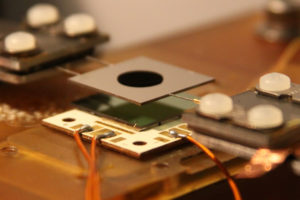
A prototype of the new solar cell
The sun gives us so much, providing both lighting and heating for our planet. We try to take advantage of this constant stream of power by using solar panels to convert light into electrical energy. It’s a bright idea. But, could we be harnessing more of the sun?
Researchers at MIT think so. In a paper published this week in Nature Energy researchers describe building a working solar thermophotovoltaic device, or STPV. The STPV solar cell has a layer that absorbs heat and light from sunlight and reflects it back out as light, which is then captured by a nearby solar cell and turned into power. The light emitted by the device is calibrated to be the perfect wavelength for the solar cell, making it function at peak efficiency. Normally, a solar cell or photovoltaic device just convert light into electricity without going through the intermediate step with heat.
Heat is energy that is constantly wasted, just dispersing […]











This links to the wrong article at the top.
Link has been updated to the correct article.
How does S(olar) R(adiation) M(anagment) aka ch.trails fit into this picture?
That’s how Dane Wigington (GeoEngineeringWatch.org) started to find out about the detrimental effect of the airial spraying. The effectiveness of his solar panels diminished after the ch.trails appeared. He is an expert in that field.